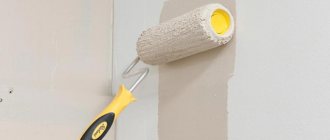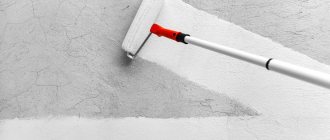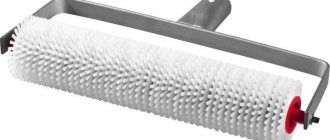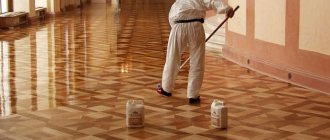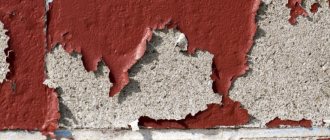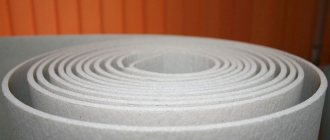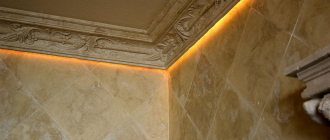For acrylic paint roller
Many people buy expensive materials for repairs, but completely forget that the application tools are also important. Therefore, saving on them is not entirely the right decision. The smoothness and uniformity of the coating will depend on what you use to apply the paint. Cheap brushes leave streaks and unevenness behind, so it's best to use a roller. Find out which roller is best for acrylic or other types of paint, and what material it should be made of, from our article.
Preparing walls for painting with a roller
After purchasing the tools and paint material, you can move on to the next stage - preparing the room for painting. If possible, remove furniture from the room; if this is not possible, then it is compactly placed in the center of the room, completely covered with polyethylene or special capes. To keep windows and door panels clean, use film, securing its ends with masking tape. Skirting boards and door openings are also protected with masking tape.
To effectively paint the entire surface of the walls, it is better to dismantle heating appliances (radiators). For this:
- tightly close the shut-off valves at the entrance to the heating system;
- install a tray under the battery to collect water;
- unscrew the connection points between the device and the general system and drain the water;
- dismantle the radiator.
When all the preparatory work has been completed, we proceed directly to painting. It's best to start with a small area and see how long the paint takes to dry and what the results are. If you like everything, paint the whole room.
Advice. The power supply to the room should be turned off in advance to protect yourself and others from accidental electric shock. Masking tape is applied to open areas with removed sockets.
Some wallpaper requires additional painting after gluing to the wall. Such wallpapers very often help to find quite original and interesting color solutions for interior decoration. How to paint wallpaper for painting? To effectively apply the coloring liquid to the surface, a high-quality wallpaper roller is required. When making such a choice, you need to pay attention to the shaft itself. It is desirable that the nozzle material be homogeneous. The length of the pile is almost always the same and ranges from 5-25 mm. The holder must be attached to the body firmly, securely and comfortably for the hand. The roller should be easy to remove and rotate freely.
Choosing the width and diameter of the roller for acrylic paint
If your choice is acrylic, the length and material of the tool must be selected more carefully. Why do most masters advise choosing a roller? The main reasons are:
- quick application to the surface;
- does not leave stains or streaks;
- blends paint perfectly;
- The acrylic composition can be applied to any surface;
- painting a large area with acrylic or any other liquid;
- you can create various effects: orange peel, notches, bulges.
The roller for acrylic paint should depend on the volume of the surface to be painted. In general, manufacturers create instruments of various sizes: from 5 to 40 cm in diameter. When choosing a device, you need to be guided only by this rule: the larger the surface area you are going to process, the wider and larger the device should be. If you need to paint the ceiling, you should choose a device no more than 30 cm wide, since a larger tool will cause inconvenience.
And also, we must not forget about the extension cord for the handle. It is extremely inconvenient to work on a chair, so it is necessary to purchase such a device. The length of the handle should reach 30 or 40 cm.
Important! When purchasing repair tools, you cannot limit yourself to just one roller. There are hard-to-reach places on the walls that can only be painted with a brush. You should purchase several brushes of different types at once. These should be oblique, curved and radiator brushes.
Choosing a roller for walls
To choose a suitable roller, you first need to decide what kind of paint you will work with. It is best to paint the internal surfaces of walls with water-based and acrylic painting materials, since they are perfectly diluted with water, are non-toxic, have a high degree of drying, and most importantly, are harmless to the human body. These paints can be used to cover any surface - wooden structures, stone, concrete and brick. Paints allow the wall material to “breathe”, make their surface rich and bright and do not lose their attractive and decorative appearance for a long time.
Wanting to give your interior a unique look, decorative paint is often used. A textured foam roller is suitable for this type of paint. The result is a textured surface after drying.
Modern construction supermarkets offer a huge number of tools and devices of various types, and choosing the right sample sometimes confuses the buyer. How to choose the right nozzle? Paint rollers are classified according to the following criteria:
- 1. Material of the soft paint part of the tool.
On the packaging of a high-quality roller, the product marking is indicated only in Latin letters. This means that high-quality material was used to make the construction tool. The absence of one indicates the low quality of the product. It can only be used for home repairs in small areas.
- 2. Soft element texture.
There are rollers made of artificial and natural materials. Fur tips are the most expensive. Felt and rubber are equivalent to artificial ones. Natural rollers have the highest degree of contact with the surface being treated. According to the method of application, depending on the quality of the nozzle, rollers are divided for walls and floors.
- 3. Shape and size of the roller.
For painting complex configurations and corners, small-sized products are used. The width of the nozzle is of particular importance. To paint small areas in an apartment, it is enough to take a sample 20 - 30 centimeters wide.
So which roller is best to paint walls with water-based paint? The choice of construction tool depends on the composition of the paint and varnish coating and the surface being treated; for example, for applying water-based paint, primer and liquid glue, a regular foam rubber attachment is more suitable.
When planning renovations on their own, many craftsmen wonder what roller to use to paint walls with acrylic paint and water-based compounds? The most popular rollers are foam rubber. This material wears out quickly, but at the same time, it is an inexpensive tool. For smooth walls you need to use fur rollers. The rubber nozzle is more used to create different textures.
Advice. When purchasing a roller for water-based paint for walls, do not forget to purchase additional accessories in the form of an extended holder, a grater and several replacement attachments.
Features of choosing a fur coat
When purchasing repair equipment, you should pay special attention to the material from which the roller is made. After working with some tools, lint, hair and other unwanted things may remain on the wall. Therefore, you need to know how to work with these devices and what paints they are suitable for.
Foam rubber
Foam rubber is least suitable for applying acrylic paint. Only a true specialist can use such a roller, but a beginner will have to suffer. This material, unfortunately, is short-lived and quickly absorbs liquid, which is not economical. It is inconvenient to use this device for painting, as the paint drips copiously onto the floor.
Important! Craftsmen do not recommend using foam rubber devices for painting with aggressive paints or other liquids - enamel or an oil mixture. These liquids corrode the foam rubber, which remains on the wall in the form of small pieces. In addition, it leaves bubbles and streaks on the wall.
Pile, fur
Using a pile, you can apply any paint or other composition to the wall. When purchasing such a tool, you need to pay attention to the length of the bristles. A device with medium pile is excellent for applying water-based composition. If you need to apply a thick layer of acrylic to the wall, you should purchase a device with long pile, as such a roller absorbs more of the composition. But you need to take into account that working with such a tool is much harder, because the muscles of the hands will tense under the weight of the soaked bristles and then ache. Experts recommend buying a roller with medium pile - this is a universal product for painting any walls. If you need a thin layer of paint, you need to purchase a device with short pile. The minimum length of the pile reaches 5 mm, and the maximum is 26 mm.
A fur roller is perfect for applying oil compositions or enamel. When painting, it is tedious to take into account that lint and hairs can remain on the wall and create defects.
Important! If you choose a lint device, you should soak it for 3 or 4 hours before use. This way you can achieve maximum rigidity of the fibers, which is extremely important for the uniform application of acrylic or any other composition.
Velours
Velor is suitable for applying aggressive liquids and solvents. This device can be used to cover any surface. This is a universal remedy that has virtually no drawbacks. The only downside is that velor absorbs liquid very quickly, so you will have to dip it into the composition much more often.
Polyamide
Professional painters often choose a polyamide roller or a lint tool. It is quite difficult to use in work, since the acrylic composition is absorbed quickly and spreads over the walls. But this is a long-lasting device that can be used to apply any composition to all surfaces known to us. This tool must be used very carefully to avoid splashing liquid, so it is not recommended for beginners. This device is also great for applying acrylic composition.
We must not forget that the device must be washed with a solution after use: this way it can be used many times.
What are the differences in roller design?
Although ceiling rollers are a simple tool, the different classifications of this construction tool stand out. Any roller used to paint the ceiling surface differs in the size of the rotating drum.
Its diameter is:
· 50-100 mm;
· 100-150 mm;
· 180-250 mm.
The handle of a construction tool can also be different (its name is a clasp) - depending on the parameters of the drum, its length varies between 150-500 mm.
Important! The longer the tool’s clasp, the easier it is for them to carry out the work (this applies to painting the ceiling, which is done at a height and without any amenities).
The speed of painting the surface depends on the diameter of the drum, so you need to choose them carefully. How to choose a roller for painting the ceiling? To make the right choice, you first need to estimate the area that needs to be processed. It is known that the larger the diameter of the product, the larger the area it can cover. Therefore, if the stripes are wide, it will be possible to carry out finishing work faster.
Advice! When thinking about which roller is better, you need to take into account that the large drum is capable of absorbing a lot of liquid. This makes the job much more difficult because the fixture becomes heavy. For example, if 200 mm rollers are used for painting, it is not difficult to keep them suspended, but the builder will have to apply more stripes.
Choosing a roller with a diameter of 300 mm is good because the tool will cope with the task faster, but the painter’s hand will get very tired. In this case, the positive “outcome” of the event is considered to be an increase in the size of the handle, which will allow you not to use a stepladder during painting.
Which roller is better?
Different types of tools should be selected for different surfaces. Let's figure out which roller to paint the ceiling with, and which one is more convenient to paint concrete walls or wallpaper.
Paint the ceiling
Usually, water-based or acrylic paints are used to paint the ceiling, so let’s figure out first which roller is better for painting with water-based paint.
Water-based dispersion paints and water-based paints are best applied with a fur-lined tool. The length of the fibers must be selected from 12 mm. Considering that paint needs to be applied from below and the paint composition tends to fall to the floor, workers have to ensure a supply of paint in the tool to prevent skips. It is the long and medium pile that will ensure uniform coloring of the entire surface of the ceiling without streaks.
When painting the ceiling with a roller, you need to pay attention to one more characteristic - the width of the working part. The ceiling surface is most often a large, flat space, and therefore, to paint it, choose rollers of large width - at least 250 mm. The same applies to the diameter; the larger the diameter of the roller, the faster and easier it is to apply paint to the ceiling.
Painting the ceiling from a stepladder or trestle is not always convenient and safe, so for such work you need to select rollers with a long or telescopic handle. In this way, you can paint the ceiling without using a height, i.e. straight from the floor. In addition, this position of the technician allows you to quickly identify unevenness of the coating and correct deficiencies.
To paint walls
The choice of which roller is best to paint walls depends on the texture and material of the base, as well as the type of paint:
- if you are going to paint wooden walls with water-based paint, a medium-width roller with foam rubber will do;
- for processing smooth concrete surfaces, it is better to choose fur rollers with medium-sized bristles or skins made of polyamide threads;
- textured images are applied to the walls using rollers with an elastic rubberized or foam base;
- Velor skins are considered universal roller skins, suitable for painting walls with any paint composition.
Paint wallpaper
To figure out which roller to choose for painting wallpaper, you need to understand that wallpaper to be painted usually has a relief pattern, so it is important to paint the texture to its full depth. The choice should be made on rollers with fur or velor skin and medium pile. If the depth of the relief on the wallpaper is large, choose a pile from 18 mm.
Roller technology
To get a perfectly smooth and neatly painted surface, you need the correct technique for working with a roller. It has characteristic features:
- Painting boundaries are marked with masking tape. It must be at the same level, which is checked with a spirit or laser level. When gluing the tape, it is advisable to press it for a tight fit to avoid water-based paint getting under it. The height, shape, size and location of the tape can be any - vertical, horizontal, high or low. It depends on the intended interior and the taste of the owner. The tape is removed when the coating is completely dry.
- The roller should not be completely immersed in the paint; the axis of the tool must remain dry. Several twisting movements are made on the ribbed wall of the pallet to evenly distribute the paint throughout the masking tape, which can be removed, washed and stored upon completion of the repair.
- The movements of the roller should resemble the letter W, that is, up and down, if horizontally, then from left to right, with a brush in some narrow places crosswise. Vertical movements in one direction leave marks. Knowing how to paint walls with a roller without streaks, you can get the perfect result.
- The sequence of work is to paint the ceiling first, then the walls. Usually start from a corner or doorway. A small roller is used here
- You shouldn’t apply a lot of paint in one stroke; smudges and drops should be rolled out. Often one layer of water-based paint is not enough. They are applied at least two, and each subsequent one when the previous one is completely dry.
- If the strokes are uneven, the roller is renewed.
- If it is not possible to remove the furniture, it is moved to the middle of the room, covered with covers or film, which is secured with masking tape. The same is done with doors and windows. Water-based paint drips from such surfaces are difficult to remove.
- For high-quality painting near electrical wiring, the power must be turned off, and the sockets must be protected with the same tape.
- After completing the painting of the walls, all switches and sockets that were dismantled at the beginning of the work are installed in their places, the floor is cleaned, and covers are removed from the furniture.
You should not delay working with a roller and water-based paint. Water, absorbed into the surface, evaporates quickly.
Before you start painting, you should put on clothes that you won’t mind throwing away afterwards. This knowledge can be useful when using paints with oil, enamel and other compositions, because the basic principles of working with a roller are the same.
Recommendations for selection depending on the type of paint
Let's look at which rollers should be used depending on the type of paint composition.
Water-based
Any type of roller is suitable for working with water-based paint, but you should take into account the characteristics of the base on which the paint is applied. It is better to use fur skins for the ceiling, and foam rubber and velor for the walls. We wrote about painting with water-based emulsion here.
Acrylic
Just like with water-based paint, any roller skins are suitable for acrylic paint.
Alkyd
The rather aggressive composition of alkyd paints is not suitable for foam rollers. In this case, it is better to choose a fur or velor roller.
Oil paint and enamel
These coloring compounds, like alkyd ones, are considered aggressive, and therefore, to paint the surface with oil paint or enamel, you need to choose durable velor rollers.
Latex, silicate, varnish
To evenly apply latex or silicate paint to the surface, it is better to use fur rollers with a small pile. For varnish, the length of the pile should not exceed 6 mm.
Graduated from the Faculty of Industrial and Civil Engineering ALTI.
- Step-by-step instructions for installing a PVC window sill
- Guide to self-installation of interior doors
All about construction and renovation
2013–2020 © Self-construction - a site for those who build!
Advantages of a roller with automatic paint supply.
Of course, such an auxiliary element has a number of advantages, and it is on the basis of them that one can conclude whether you need such equipment, or whether it is better to postpone the purchase of the device for some time.
- The first and main advantage is the fact that most of the devices produced by different brands are safe with regard to splashing and the formation of drops on the material at the time of applying the coating itself.
- The second advantage is the fact that they greatly increase the working length. Often it can be stretched from 40 cm to 120. What does this mean? It's simple, you will be able to reduce paint consumption and apply it to a larger surface than you would with a standard brush.
- All models are modern, which guarantees that cleaning such a device will be simple and effective due to the universal connections to the water tap. Some models do not have universal connections, however, the kit includes quite practical and reliable adapters.
- Models often have a long cord, which allows you to paint large areas at a time.
- The application of paint using this model will be uniform, which means that no special skills are needed for this process.
- The devices also imply the fact that the user has a free choice of any water-based paints.
- Such rollers are practical, since most models are equipped with comfortable handles, both for operation and for transportation.
Types of rollers
Rollers are designed for painting large areas. They are used for facade work on the outside of the building and for renovations in the apartment. There are many types of this tool available in stores, and in order for a home craftsman to be able to buy exactly what he needs, he should understand the principle of operation of the roller, its design and existing types.
Operating principle and design
- Submersible type. These are traditional rollers that are dipped into a dye solution, rolled out on a flat surface to remove paint drips and soak it evenly over the sandpaper (usually using a ditch), and then begin to paint.
- Automatic. In this design, the paint enters the drum under pressure through a hose or is poured by hand. The paint, seeping through the holes, gets onto the skin, evenly distributed along its length. This approach helps save on paint.
Nature of work
Depending on the nature of the work performed, rollers are divided into two types:
- Exterior. Designed for outdoor use and have a more rigid, reinforced base. Width from 400 mm.
- Interior. Softer rollers for interior work. Width from 20 mm.
Coverage type
Rollers are distinguished by coating material:
- fur. Roller skins made from faux or natural fur are considered universal. This material ensures uniform coloring of any surface and saves material. When working with a fur roller, a minimal amount of splashes and drops is formed, and it can be used to perform even the most demanding tasks. They differ in pile length. For painting uneven surfaces, it is recommended to choose sandpapers with longer piles, however, during work, individual fibers may stick to the base;
- foam rubber. The cheapest type of skin. It is distinguished not only by low cost, but also by a short period of use. Foam rubber is not suitable for every type of paint. During operation, it leaves a lot of splashes and paints uneven surfaces poorly;
- velor As with foam rubber, working with a roller with velor sandpaper requires experience - a novice master will not be able to cope with the abundance of splashes. Velor is great for working with varnishes over a large area. Velor rollers absorb a lot of paint, and therefore the material consumption during operation will be high;
- thread They are also inexpensive types of roller skins. Thread products are durable and suitable for applying any coloring compositions to the surface, but due to the abundance of splashes during operation, consumption cannot be called economical;
- flock. Designed to work with perfectly flat surfaces. They are inexpensive, but you should be careful when working with them - flock skins create a lot of splashes.
Villi length
According to this parameter, skins are divided into three categories:
- With high pile. Designed for processing uneven surfaces. The best option for painting brick walls and concrete. The length of the villi is from 18 to 22 mm.
- With medium pile. Designed for painting wooden surfaces, plasterboard walls and ceilings. Pile length is from 11 to 12 mm.
- With short pile. Small pile allows you to save material, but you can only work with it on well-leveled surfaces. Typically, fine-pile skins are used to treat metal and wooden surfaces. Dina of villi from 5 mm.
Roller pile length
Replaceable roller attachments are available with pile lengths from 4 to 25 mm. The choice of pile length depends on the quality of the surface being treated - the more unevenness there is on the wall, the longer the pile length needs to be used . For smooth walls, short-pile coats (4-9 mm) are used, which will evenly distribute the paint over the prepared wall. If you use a long-nap roller to smooth the surface, excess paint will form smudges and streaks.
For embossed wallpaper, textured plaster and rough surfaces, rollers with a pile length of 12-25 mm are used. Thanks to the sufficient length of the pile, the paint penetrates into all the depressions, recesses and protrusions on the wall. A short pile will not cope with such a task and will leave unpainted areas.
Which roller is better?
Different types of tools should be selected for different surfaces. Let's figure out which roller to paint the ceiling with, and which one is more convenient to paint concrete walls or wallpaper.
Paint the ceiling
Usually, water-based or acrylic paints are used to paint the ceiling, so let’s figure out first which roller is better for painting with water-based paint.
Water-based dispersion paints and water-based paints are best applied with a fur-lined tool. The length of the fibers must be selected from 12 mm. Considering that paint needs to be applied from below and the paint composition tends to fall to the floor, workers have to ensure a supply of paint in the tool to prevent skips. It is the long and medium pile that will ensure uniform coloring of the entire surface of the ceiling without streaks.
When painting the ceiling with a roller, you need to pay attention to one more characteristic - the width of the working part. The ceiling surface is most often a large, flat space, and therefore, to paint it, choose rollers of large width - at least 250 mm. The same applies to the diameter; the larger the diameter of the roller, the faster and easier it is to apply paint to the ceiling.
Painting the ceiling from a stepladder or trestle is not always convenient and safe, so for such work you need to select rollers with a long or telescopic handle. In this way, you can paint the ceiling without using a height, i.e. straight from the floor. In addition, this position of the technician allows you to quickly identify unevenness of the coating and correct deficiencies.
To paint walls
The choice of which roller is best to paint walls depends on the texture and material of the base, as well as the type of paint:
- if you are going to paint wooden walls with water-based paint, a medium-width roller with foam rubber will do;
- for processing smooth concrete surfaces, it is better to choose fur rollers with medium-sized bristles or skins made of polyamide threads;
- textured images are applied to the walls using rollers with an elastic rubberized or foam base;
- Velor skins are considered universal roller skins, suitable for painting walls with any paint composition.
Paint wallpaper
To figure out which roller to choose for painting wallpaper, you need to understand that wallpaper to be painted usually has a relief pattern, so it is important to paint the texture to its full depth. The choice should be made on rollers with fur or velor skin and medium pile. If the depth of the relief on the wallpaper is large, choose a pile from 18 mm.
New fur pelts often leave individual hairs on the surface being dyed. In the case of a ceiling or walls, this is not so noticeable, but on textured wallpaper, individual hairs will be striking. Experienced builders recommend rolling the new roller over the adhesive side of the tape before starting work, then the problem can be avoided.
In addition, a roller with velor sandpaper can be used to prepare a wall for covering with quartz and non-woven wallpaper.
Prime the walls
Almost all types of rollers are suitable for working with primer, but you can select the optimal rollers for different compositions.
So, foam rollers are suitable if you need to prime concrete surfaces with viscous compounds. For liquid solutions, foam rubber will be inconvenient.
Fur rollers are considered universal, with which you can apply primer of any consistency. For work, choose skins with medium and long pile.
It is best to cover smooth surfaces, such as drywall, with primer using velor rollers with a pile length of up to 6 mm.
Roller sizes
The choice of roller is influenced by the size of the surface to be processed - for a larger area, choose a tool of greater length and diameter. Depending on the size, paint rollers can be divided into three groups:
Universal (standard)
The length of universal rollers is 140-250 mm. Professionals consider a 180 mm roller attachment to be the best option, which is why tools with standard sizes are most often used for painting work.
Facade
Facade rollers usually have a large diameter and a length of 180 to 270 mm. When impregnating wood, painting a foundation or a large floor covering, high quality finishing is not required, so it is more advisable to use oversized rollers.
Small rollers
The length of small rollers ranges from 50 to 150 mm. They are convenient for painting corners, narrow surfaces and hard-to-reach places.
Recommendations for selection depending on the type of paint
Let's look at which rollers should be used depending on the type of paint composition.
Water-based
Any type of roller is suitable for working with water-based paint, but you should take into account the characteristics of the base on which the paint is applied. It is better to use fur skins for the ceiling, and foam rubber and velor for the walls. We wrote about painting with water-based emulsion here.
Acrylic
Just like with water-based paint, any roller skins are suitable for acrylic paint.
Alkyd
The rather aggressive composition of alkyd paints is not suitable for foam rollers. In this case, it is better to choose a fur or velor roller.
Oil paint and enamel
These coloring compounds, like alkyd ones, are considered aggressive, and therefore, to paint the surface with oil paint or enamel, you need to choose durable velor rollers.
What kind of work is a roller ideal for?
As we said above, this tool is suitable for painting large flat surfaces. In this case, we can make sweeping movements, in a small number of which we cover the surface with a layer of paint. In this case, both the wall and the ceiling act as such a surface. Or you can apply not paint at all, but glue to the same back side of the wallpaper. And the most convenient way to do this is with a roller. And for each of these operations a different type of roller is suitable, the choice of which we want to talk about next.
Acrylic coating or latex: which is better and what is the difference?
Acrylic-based paints are very popular these days. After drying, the acrylic material forms a durable matte film. This coating fits well on any lacquered surface, dries quickly, is not afraid of wet cleaning, does not fade in the sun, is inert to high temperatures, and is quite resistant to abrasion.
Important! Do not forget that acrylic paints are not intended for rooms where frequent exposure to water is possible.
This coating is used mainly for painting and finishing ceilings and decorating walls with artistic painting.
Latex paints are a water-based emulsion with latex pigments as a binder. The average drying time is a maximum of 2 hours, resulting in a thin, glossy film. This coating has advantages over other painting materials in that the thickness of the coating can be minimal and convey the entire texture of the element being painted.
Each material has its pros and cons. It is difficult to say which paint is better; it depends on the tasks assigned during the repair and on the price range. When choosing a paint, everyone must determine for themselves: for what purposes this or that coating is needed.
Useful! Latex material is used for ceilings, walls, wallpaper, and painting plaster. The coating is not at all afraid of water and wet rooms, and prevents the formation of mold on the treated surface.
